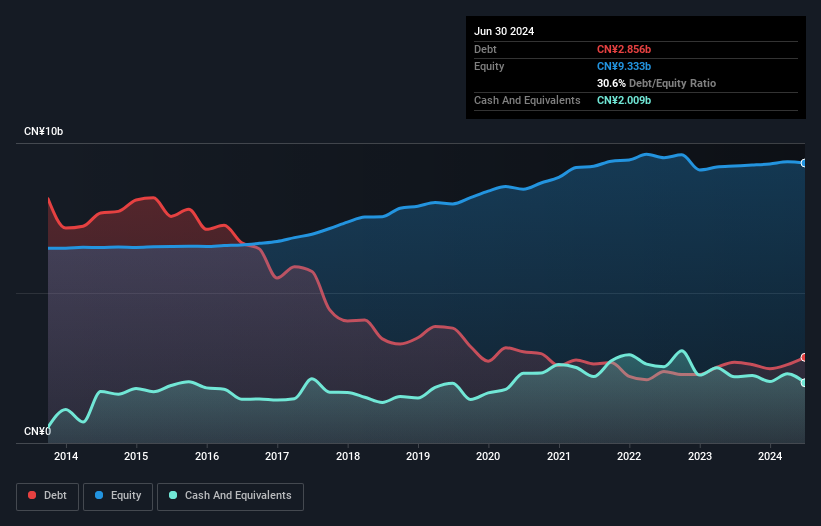- China
- /
- Paper and Forestry Products
- /
- SHSE:600308
Does Shandong Huatai Paper Industry ShareholdingLtd (SHSE:600308) Have A Healthy Balance Sheet?

Howard Marks put it nicely when he said that, rather than worrying about share price volatility, 'The possibility of permanent loss is the risk I worry about... and every practical investor I know worries about.' When we think about how risky a company is, we always like to look at its use of debt, since debt overload can lead to ruin. Importantly, Shandong Huatai Paper Industry Shareholding Co.,Ltd (SHSE:600308) does carry debt. But is this debt a concern to shareholders?
Why Does Debt Bring Risk?
Debt is a tool to help businesses grow, but if a business is incapable of paying off its lenders, then it exists at their mercy. Part and parcel of capitalism is the process of 'creative destruction' where failed businesses are mercilessly liquidated by their bankers. However, a more usual (but still expensive) situation is where a company must dilute shareholders at a cheap share price simply to get debt under control. Having said that, the most common situation is where a company manages its debt reasonably well - and to its own advantage. When we examine debt levels, we first consider both cash and debt levels, together.
Check out our latest analysis for Shandong Huatai Paper Industry ShareholdingLtd
What Is Shandong Huatai Paper Industry ShareholdingLtd's Net Debt?
As you can see below, at the end of June 2024, Shandong Huatai Paper Industry ShareholdingLtd had CN¥2.86b of debt, up from CN¥2.69b a year ago. Click the image for more detail. However, because it has a cash reserve of CN¥2.01b, its net debt is less, at about CN¥847.5m.

A Look At Shandong Huatai Paper Industry ShareholdingLtd's Liabilities
The latest balance sheet data shows that Shandong Huatai Paper Industry ShareholdingLtd had liabilities of CN¥4.75b due within a year, and liabilities of CN¥1.43b falling due after that. On the other hand, it had cash of CN¥2.01b and CN¥2.41b worth of receivables due within a year. So its liabilities outweigh the sum of its cash and (near-term) receivables by CN¥1.76b.
This deficit isn't so bad because Shandong Huatai Paper Industry ShareholdingLtd is worth CN¥4.92b, and thus could probably raise enough capital to shore up its balance sheet, if the need arose. But it's clear that we should definitely closely examine whether it can manage its debt without dilution.
We use two main ratios to inform us about debt levels relative to earnings. The first is net debt divided by earnings before interest, tax, depreciation, and amortization (EBITDA), while the second is how many times its earnings before interest and tax (EBIT) covers its interest expense (or its interest cover, for short). This way, we consider both the absolute quantum of the debt, as well as the interest rates paid on it.
Shandong Huatai Paper Industry ShareholdingLtd has a low net debt to EBITDA ratio of only 0.89. And its EBIT easily covers its interest expense, being 31.3 times the size. So you could argue it is no more threatened by its debt than an elephant is by a mouse. The modesty of its debt load may become crucial for Shandong Huatai Paper Industry ShareholdingLtd if management cannot prevent a repeat of the 82% cut to EBIT over the last year. When it comes to paying off debt, falling earnings are no more useful than sugary sodas are for your health. When analysing debt levels, the balance sheet is the obvious place to start. But it is Shandong Huatai Paper Industry ShareholdingLtd's earnings that will influence how the balance sheet holds up in the future. So if you're keen to discover more about its earnings, it might be worth checking out this graph of its long term earnings trend.
Finally, a company can only pay off debt with cold hard cash, not accounting profits. So we clearly need to look at whether that EBIT is leading to corresponding free cash flow. During the last three years, Shandong Huatai Paper Industry ShareholdingLtd burned a lot of cash. While investors are no doubt expecting a reversal of that situation in due course, it clearly does mean its use of debt is more risky.
Our View
On the face of it, Shandong Huatai Paper Industry ShareholdingLtd's conversion of EBIT to free cash flow left us tentative about the stock, and its EBIT growth rate was no more enticing than the one empty restaurant on the busiest night of the year. But at least it's pretty decent at covering its interest expense with its EBIT; that's encouraging. Looking at the balance sheet and taking into account all these factors, we do believe that debt is making Shandong Huatai Paper Industry ShareholdingLtd stock a bit risky. Some people like that sort of risk, but we're mindful of the potential pitfalls, so we'd probably prefer it carry less debt. When analysing debt levels, the balance sheet is the obvious place to start. But ultimately, every company can contain risks that exist outside of the balance sheet. Case in point: We've spotted 3 warning signs for Shandong Huatai Paper Industry ShareholdingLtd you should be aware of, and 1 of them can't be ignored.
If, after all that, you're more interested in a fast growing company with a rock-solid balance sheet, then check out our list of net cash growth stocks without delay.
If you're looking to trade Shandong Huatai Paper Industry ShareholdingLtd, open an account with the lowest-cost platform trusted by professionals, Interactive Brokers.
With clients in over 200 countries and territories, and access to 160 markets, IBKR lets you trade stocks, options, futures, forex, bonds and funds from a single integrated account.
Enjoy no hidden fees, no account minimums, and FX conversion rates as low as 0.03%, far better than what most brokers offer.
Sponsored ContentNew: Manage All Your Stock Portfolios in One Place
We've created the ultimate portfolio companion for stock investors, and it's free.
• Connect an unlimited number of Portfolios and see your total in one currency
• Be alerted to new Warning Signs or Risks via email or mobile
• Track the Fair Value of your stocks
Have feedback on this article? Concerned about the content? Get in touch with us directly. Alternatively, email editorial-team (at) simplywallst.com.
This article by Simply Wall St is general in nature. We provide commentary based on historical data and analyst forecasts only using an unbiased methodology and our articles are not intended to be financial advice. It does not constitute a recommendation to buy or sell any stock, and does not take account of your objectives, or your financial situation. We aim to bring you long-term focused analysis driven by fundamental data. Note that our analysis may not factor in the latest price-sensitive company announcements or qualitative material. Simply Wall St has no position in any stocks mentioned.
About SHSE:600308
Shandong Huatai Paper Industry ShareholdingLtd
Engages in the manufacture and sale of paper products in China.
Adequate balance sheet and slightly overvalued.
Market Insights
Community Narratives




